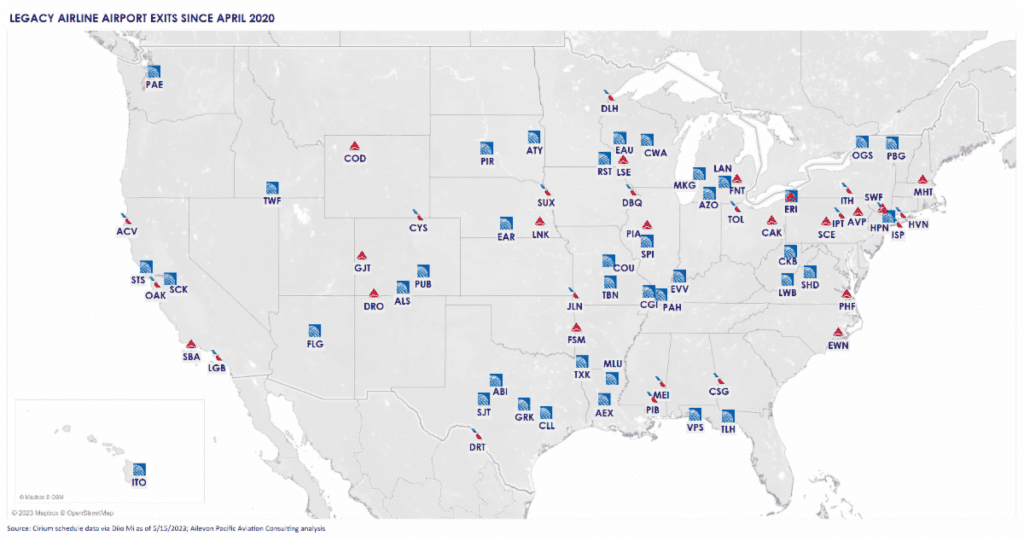Dwindling air service to small cities across the U.S. is the result of changing airline economics, and not just the pilot shortage airlines face, long-time industry analyst William Swelbar said Wednesday.
“This is all about economics … it really is a lot more than pilots,” the chief industry analyst at the Swelbar-Zhong Consultancy said at a U.S. National Transportation Research Board meeting in Washington, D.C.
The high cost of flying small planes, which has increased dramatically along with so many other airline industry expenses, along with limited pilot resources, has contributed to network carriers American Airlines, Delta Air Lines, and United Airlines deciding to end flights to cities like New Haven, Conn., Toledo, Ohio, and Williamsport, Pa. Those air service losses have raised questions about the future of such service, both in the industry and Congress, and threatens what the Regional Airline Association (RAA) says is $152 billion in economic activity flights bring to small communities.
Small U.S. cities have been losing air service for decades. As planes grew in size, and fuel prices and other expenses rose, airline planners could not make the math work for destinations like Farmington, N.M., or Hickory, N.C. — last served by US Airways in 2008 and Delta in 2006, respectively, according to Cirium Diio schedules. The trend has accelerated as the industry emerged from the pandemic facing a pilot shortage (now focused on captains), higher costs, supply chain issues, and a more challenging operating environment.
“You can’t run your airline like it’s 2019,” United CEO Scott Kirby said in April. “It’s different and harder now.”
A recent analysis by Ailevon Pacific Aviation Consulting found that American, Delta, and United have exited a combined 74 markets since April 2020. Not all of those markets have lost all commercial air service. For example, the number includes United’s decision to exit Erie, Pa., in June; American continues to serve the Pennsylvania city.

The rapid disappearance in the U.S. of 50-seat regional jets, whether Bombardier CRJ200s or Embraer ERJ-145s, contributes to the situation. Whether due to the pilot shortage, economic trends, or other reasons, American, Delta, and United all flew at least 300 fewer small jets at the end of March than they did four years earlier. And Delta has gone as far as to say will “exit” the type entirely this summer; that is except for 50-seat regional jets flown by SkyWest Airlines at its own risk on federally subsidized routes that Delta does not count in its fleet plan.
The question of regional flying economics came into sharp focus last year. That’s when American unilaterally raised pilot pay rates at three of its wholly-owned affiliates to levels comparable with those paid at budget, or ultra low-cost, airlines. The increase has since been matched at most regional airlines, and forced further changes in the space, including the retirement of many 50-seat jets.
“Regional pilot pay doubling is really going to hurt communities,” Raymond James analyst Savanthi Syth said of the increases in January. “In the smaller communities, it’s really going to have a longer term impact.”
American has repeatedly defended the move. Chief Revenue Officer Vasu Raja said last year that the airline could cover the increased expense with the higher yields it generates from having a broader regional network than competitors.
Swelbar agreed with Raja’s comments, and added that American’s ownership of the regional affiliates in question — Envoy, Piedmont Airlines, and PSA Airlines — changes the cost equation.
But the writing may be on the wall for a place like Erie. American’s schedule of only two daily flights to Charlotte offers limited utility to connecting travelers and increases the likelihood that they will drive to a larger airport nearby. In Erie’s case, the Buffalo, Cleveland, and Pittsburgh airports are all within a roughly two-hour drive.
“Below three frequencies a day, [air service is] really vulnerable,” Swelbar said.
Binghamton and Elmira, N.Y., Columbus and Valdosta, Ga., and Roswell, N.M., are among other U.S. cities that have fewer than three daily flights scheduled in June, Diio data show.
And ULCCs, like Allegiant Air and Spirit Airlines, are not panaceas for small markets. The airlines tend to operate routes with just several flights a week, catering to holidaygoers headed to, say, Orlando but not the corporate traveler on a sales trip or to a conference. This is the case in both New Haven and Toledo where Avelo Airlines and Allegiant, respectively, continue to fly.
“As you see network carriers come out, and ULCCs go in, the quality of air service is going to go down because you don’t connect anybody,” Swelbar said.
One strategy some small airlines have embraced to maintain air service to small cities relates to the Federal Aviation Administration’s Part 135 and 380 certifications. The model, which is used by Contour Airlines and JSX, allows so-called public charter carriers to fly planes with up to 30 seats on scheduled flights but with pilots that need significantly fewer hours of training than the 1,500 hours required under standard Part 121 airline certification rules. SkyWest is in the process of setting up its own such operator, named SkyWest Charter, to take over federally subsidized air routes.
“It’s a feel-good air service for the sake of air service thing,” Swelbar said on the model. He cited the fact that these flights are unable to carry a major airline’s code — for example, “UA” for United — and offer limited connectivity to the broader market.
The major airline unions, including the Air Line Pilots Association (ALPA) and the Association of Flight Attendants-CWA (AFA), have objected to the model in comments on SkyWest Charter’s certification.
“There will be more Williamsports,” Swelbar told attendees at the TRB meeting. Referring to the sole U.S. city that has lost all air service — network and ULCC — during the pandemic.





